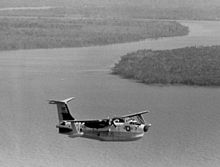Operation Market Time
Radar picket escort ships, based in Guam or Pearl Harbor, provided long-term presence at sea offshore to guard against trawler infiltration.
When a trawler was intercepted landing arms and ammunition at Vung Ro Bay in northern Khánh Hòa Province on 16 February 1965, it provided the first tangible evidence of the North Vietnamese supply operation.
At the time of inception, the Coast Guard contributed seventeen 82 feet (25 m) Point-class cutters while the Navy added approximately fifty ships known as Patrol Craft Fast (PCFs or Swifts) that could reach a maximum speed of 28 knots.
[3] In detail, on 16 April 1965 United States Secretary of the Navy Paul Nitze requested Coast Guard assistance with Market Time.
[4][5] The objective of Operation Market Time focused on preventing communist ships from infiltrating the South Vietnamese coast to resupply PAVN/VC forces.
[7] Operation Market Time was originally planned to acquire 54 Swift boats, but that number increased to a total of 84 in September 1965 to thoroughly guard the coast of South Vietnam.
U.S. Navy Martin P-5 Marlin seaplane patrol squadrons, destroyers, ocean minesweepers, PCFs and United States Coast Guard cutters performed the operation.
Of the many vessels involved in Operation Market Time, one of the more notable was the USCGC Point Welcome which, on 11 August 1966, was brought under fire by a number of United States Air Force aircraft.
[9] To stop these infiltrations, Market Time was established as a coordinated effort of long range patrol aircraft for broad reconnaissance and tracking.
These aircraft, initially SP-5B seaplanes, later P-2 Neptunes and Lockheed P-3 Orions, were armed with Bullpup air-to-surface missiles were capable of engaging these craft directly.
Under normal conditions, U.S. and allied surface forces intercepted suspect ships that crossed inside South Vietnam's 12-mile coastal boundary.
[10] By October 1967 air surveillance expanded to monitor traffic bound to and from Cambodia as at this point it had become apparent that communist supplies were being shipped to Sihanoukville which were then transported over to the South Vietnamese border in large convoy trucks.
[11] Market Time, which operated day and night, fair weather and foul, for eight and a half years, denied the North Vietnamese a means of delivering tons of war materials into South Vietnam by sea.

